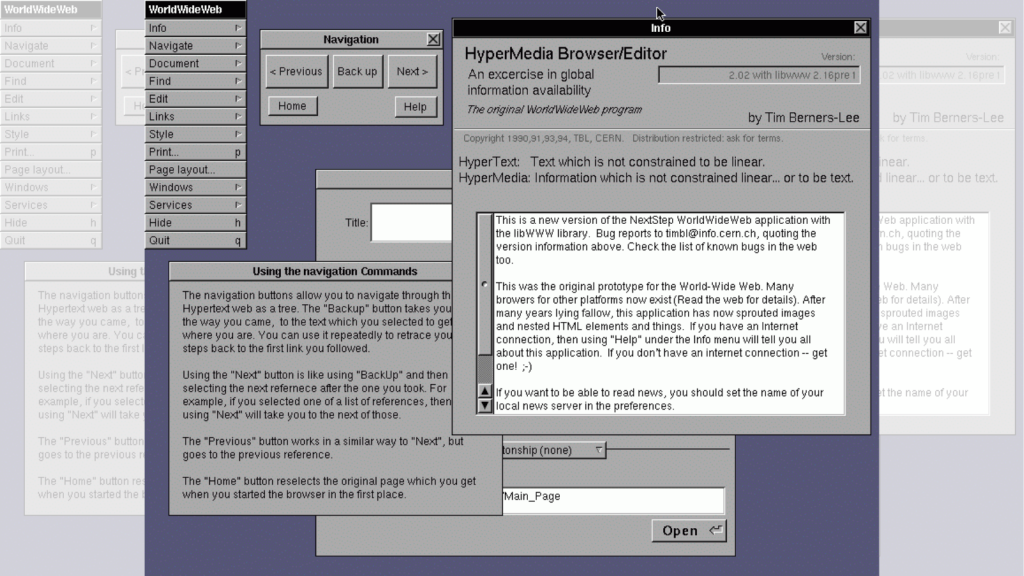The internet has become such an integral part of our daily lives that it’s hard to imagine a world without it. Yet, just a few decades ago, this vast network of information was in its infancy, filled with quirks and curiosities that have largely been forgotten. The early internet was a very different place, shaped by the limitations of technology and the pioneering spirit of its early adopters. From peculiar protocols to forgotten features, the internet’s formative years were marked by innovation, experimentation, and more than a few oddities. Here are 20 fascinating facts about the internet’s early days that might surprise you.
The First Spam Email Was Sent in 1978

Long before our inboxes were flooded with unwanted messages, the first spam email was sent on 3 May 1978. A marketing representative for Digital Equipment Corporation sent an invitation to a product demonstration to every ARPANET address on the US West Coast. This unsolicited mass email caused quite a stir and set the stage for the spam problem we face today. Interestingly, this first spam email was sent to 393 recipients, a tiny number compared to modern spam campaigns that can target millions.
The Term “Surfing the Internet” Was Coined by a Librarian

The phrase “surfing the internet” is so commonplace now that we rarely think about its origin. It was actually coined by Jean Armour Polly, a librarian from New York, in 1992. She was looking for a way to describe the act of browsing the internet and, being an avid surfer, thought the metaphor fit perfectly. Polly later wrote a book called “Surfing the Internet: An Introduction,” which became a popular guide for newcomers to the web.
The First Webcam Was Created to Monitor a Coffee Pot

In 1991, computer scientists at Cambridge University set up the first webcam to monitor the coffee pot in their break room. They were tired of making the trip to the coffee machine only to find it empty. The camera provided a live feed of the pot to their desktops, allowing them to check if there was coffee before making the journey. This “Trojan Room Coffee Pot” cam continued to broadcast until 2001, when it was finally switched off.
The @ Symbol Was Chosen Almost by Accident

The ubiquitous @ symbol in email addresses was chosen somewhat randomly. In 1971, Ray Tomlinson was developing the first system to send messages between computers. He needed a symbol to separate the username from the computer name, and the @ symbol on his keyboard seemed to fit the bill. It’s been a crucial part of email addresses ever since. Tomlinson chose @ because it was rarely used in computing at the time and wouldn’t be confused with other symbols.
The First Domain Name Was Registered in 1985

On 15 March 1985, the first domain name, symbolics.com, was registered. It belonged to a computer manufacturer called Symbolics, Inc. This marked the beginning of the domain name system we use today. Interestingly, this domain still exists and is now owned by a small investor group. The second and third domain names registered were bbn.com and think.com, both on April 24, 1985.
The Internet Was Nearly Called “The Catenet”

In the early days of network development, there was a debate about what to call the interconnected network of networks. One serious contender was “The Catenet,” short for “concatenated network.” Thankfully, the term “Internet,” short for “internetwork,” won out in the end. The term “Catenet” was proposed by Louis Pouzin, a French computer scientist who made significant contributions to the development of computer networks.
The First Internet Search Engine Wasn’t Google

While Google dominates the search engine market today, it wasn’t the first. That honour goes to “Archie,” created in 1990 by Alan Emtage, a student at McGill University in Montreal. Archie indexed FTP (File Transfer Protocol) sites and allowed users to find specific files on the internet. Unlike modern search engines, Archie didn’t index the contents of these sites, only their file names.
The Word “Spam” Comes From a Monty Python Sketch

The term “spam” for unwanted email comes from a 1970 Monty Python sketch. In the sketch, spam (the canned meat product) was ubiquitous and unavoidable in a cafe’s menu, much like how spam emails would later flood inboxes. The term was adopted by early internet users and stuck. The first major incident of email spamming occurred in 1994, when two lawyers advertised their services to thousands of Usenet newsgroups.
The First Banner Ad Appeared in 1994

The first clickable banner ad appeared on HotWired.com in October 1994. It was an ad for AT&T, and reportedly 44% of people who saw it clicked on it. This incredibly high click-through rate was likely due to the novelty of the concept at the time. The ad’s prophetic message read “Have you ever clicked your mouse right HERE? YOU WILL,” predicting the future ubiquity of online advertising.
The Internet Was Almost Destroyed in 1988

In 1988, a computer science student named Robert Morris released what became known as the Morris Worm. This self-replicating computer program spread through the internet much faster than Morris anticipated, slowing down computers to the point of unusability. It affected about 10% of all internet-connected computers at the time, causing widespread panic. Morris became the first person convicted under the US Computer Fraud and Abuse Act, although he claimed the worm was not malicious but an experiment gone wrong.
The First Social Network Was Six Degrees

While MySpace and Facebook popularised social networking, they weren’t the first. Six Degrees, launched in 1997, was the first recognisable social network. It allowed users to create profiles and connect with friends, much like modern social networks. However, it was ahead of its time and shut down in 2001. At its peak, Six Degrees had around 3.5 million registered members.
The Internet Was Originally Designed for Military Use

The precursor to the internet, ARPANET, was developed by the US Department of Defense in the 1960s. Its purpose was to create a decentralised network that could survive a nuclear attack. This design principle of decentralisation is still a fundamental aspect of the internet today. The first ARPANET transmission occurred on October 29, 1969, when a message was sent from UCLA to Stanford Research Institute.
The First Graphical Web Browser Was Called WorldWideWeb

Tim Berners-Lee, the inventor of the World Wide Web, also created the first web browser in 1990. He called it WorldWideWeb (later renamed Nexus to avoid confusion with the World Wide Web itself). It was both a browser and an editor, allowing users to view and create web pages. This browser only ran on NeXT computers, which limited its adoption, but it paved the way for more accessible browsers like Mosaic.
The Term “Weblog” Was Coined in 1997

The term “weblog” was coined by Jorn Barger in December 1997. It was later shortened to “blog” by Peter Merholz in 1999 when he jokingly broke the word into “we blog” in the sidebar of his website. This simple play on words gave us the term we use today for online journals. By 1999, there were only 23 blogs on the internet; by 2006, that number had grown to 50 million.
The First Uploaded Photo Was of a Comedy Band

The first photo uploaded to the web was posted by Tim Berners-Lee in 1992. It was a promotional shot of CERN’s all-female comedy band, Les Horribles Cernettes. This quirky choice set the tone for the billions of images that would follow in the coming decades. The photo was edited using version one of Photoshop on a colour Macintosh.
The Dancing Baby Was One of the First Viral Phenomena

In 1996, a short 3D animation of a baby dancing to a cha-cha song became one of the internet’s first viral sensations. Known as the “Dancing Baby” or “Baby Cha-Cha,” it spread rapidly through email chains and early social platforms, foreshadowing the meme culture that would later dominate the internet. The animation was created by Michael Girard and Robert Lurye as a demo for the Character Studio animation software.
The First Item Sold on eBay Was a Broken Laser Pointer

When Pierre Omidyar launched AuctionWeb (later renamed eBay) in 1995, the first item sold was a broken laser pointer for $14.83. Surprised by this sale, Omidyar contacted the winning bidder to ask if they understood that the laser pointer was broken. The buyer replied, “I’m a collector of broken laser pointers.” This quirky first sale set the tone for eBay’s future as a marketplace for all sorts of items, from the mundane to the bizarre.
The First YouTube Video Was Uploaded in 2005

The first video uploaded to YouTube was a short clip titled “Me at the zoo,” featuring co-founder Jawed Karim at the San Diego Zoo. Uploaded on April 23, 2005, the 18-second video marked the beginning of the platform that would revolutionise online video sharing. The video has since been viewed over 200 million times and remains available on the platform, serving as a time capsule of YouTube’s humble beginnings.
The Emoticon Was Invented in 1982

The first digital emoticon, the sideways smiley face :-), was proposed by Scott Fahlman in a message to an online bulletin board at Carnegie Mellon University on September 19, 1982. He suggested using it to denote jokes in online communication, unknowingly starting a trend that would evolve into the emojis we use today. Fahlman also proposed the frowning face :-(, establishing the basic principle of using punctuation marks to convey emotion in text.
The Term “Cyberspace” Was Coined by a Science Fiction Author

The term “cyberspace,” now commonly used to refer to the virtual world of the internet, was actually coined by science fiction author William Gibson. He first used it in his 1982 short story “Burning Chrome” and popularised it in his 1984 novel “Neuromancer,” long before the World Wide Web was created. Gibson described cyberspace as a “consensual hallucination” and a “graphic representation of data abstracted from the banks of every computer in the human system,” a description that’s not far from today’s internet.
21 Things Pilots Are Forbidden to Do During Flights

Have you ever wondered what rules pilots must follow while they’re in the cockpit? Being a pilot is a job that comes with a lot of responsibility and a strict set of rules to ensure the safety of everyone on board.
These rules ensure that pilots maintain the highest standards of safety and professionalism while flying. By adhering to these guidelines, they help ensure that every flight reaches its destination safely.
Read More: 21 Things Pilots Are Forbidden to Do During Flights
Katy Willis is a writer, master herbalist, master gardener, and certified canine nutritionist who has been writing since 2002. She’s finds joy in learning new and interesting things, and finds history, science, and nature endlessly fascinating.

